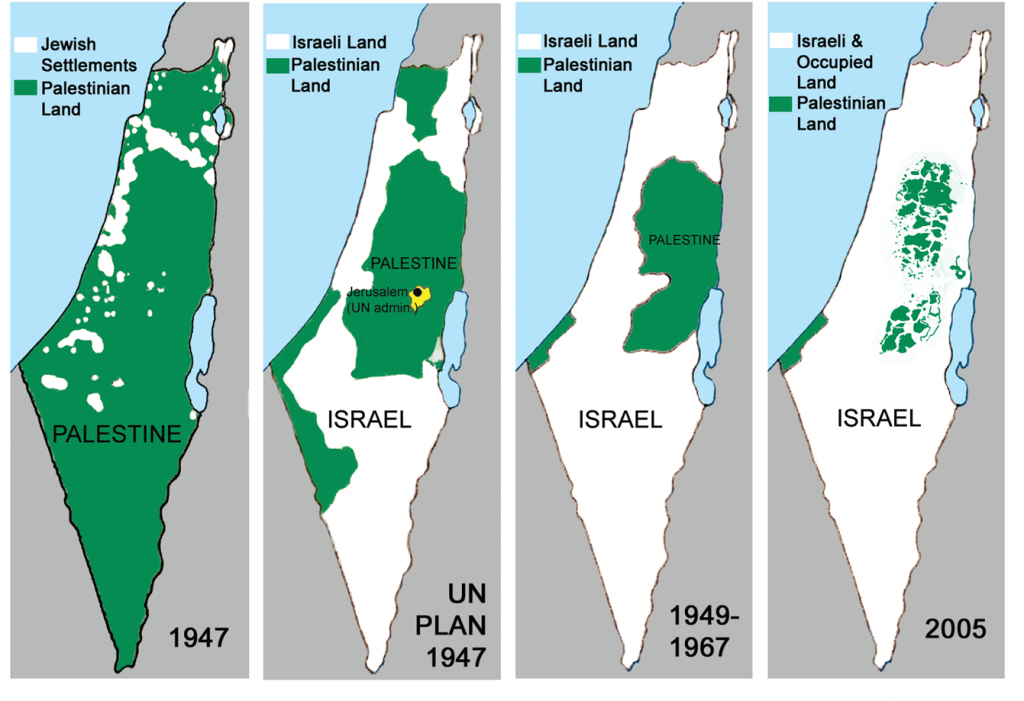Focus: Universal Declaration of Human Rights
Article 15: Everyone has the right to a nationality
Value: Wisdom
The boundaries of Israel and the occupied Palestinian territory have changed considerably since the establishment of the State of Israel in 1948.
Learning Intention: I will have developed an awareness of the changes that have taken place in the land distribution between Israelis and Palestinians since 1948 and the events which brought these about.
Success Criteria: I can talk about key events which brought about such changes in land distribution in Israel and the occupied Palestinian territory from 1948.
Activity 1
Working in groups, look closely at the four maps and consider:
- What questions do you have about why these maps have changed over time?
- What would you like to find out about these changes?
Activity 2
Using the information on the cards, create a timeline of events and answer the questions.
Activity 3
Add the maps where you think they fit on the timeline.

Photocopy and Cut Cards
|
1948 Proclamation of the State of Israel. 83% of Palestinians living on this land were forced to flee from their homes. West Bank, including East Jerusalem, came under the control of Jordan. Gaza Strip came under the control of Egypt. |
2014 2014 saw rocket attacks on Israel from Gaza and air attacks on Gaza from the Israeli military forces. By the end of the year 2,251 Palestinians, and 73 Israelis had been killed. |
|
1947 UN partition plan (to split the country in two) giving 55% of the area to a Jewish state. Conflict (war) between Israelis and Palestinians continues. |
1917 Britain stated, in the Balfour Declaration, that they would support a homeland for Jewish people on condition that nothing would be done to prejudice the civil and religious rights of existing non-Jewish communities in Palestine. The population of Palestine at the time was approximately 90% Palestinian and 10% Jewish. |
|
2005 Withdrawal of Israeli settlers from Gaza Strip. Israel continues to control all access to the area by land, sea and air. |
1942-45 During the Holocaust, 11 million people were killed by the Nazis of whom 6 million were Jews. |
|
1930s and 1940s Jewish immigration (moving to) Palestine increased greatly after WW1, especially in the 1930s. By 1936, Jewish people made up nearly 28% of the population. After WW2 there was greatly increased Jewish immigration into Palestine from Europe. |
1897 Growth of Zionist movement (Group in favour of building a homeland for Jews in Palestine). The Basle Declaration (1897) declared that the main objective of Zionism was the “colonisation of Palestine by Jewish agricultural and industrial workers”. At the time, European countries considered ‘colonisation’ to be beneficial for the colonised as well as the colonists. |
|
1967 ‘Six-Day War’ – Israel occupies (puts troops into) Gaza and The West Bank including East Jerusalem. Palestinians in these areas are still living under military rule. Israel begins to build settlements in Palestinian areas. |
1972 The ‘Munich Massacre’ – a terrorist attack on Israeli Olympic team members took place at the 1972 Summer Games in Munich. The Palestinian terrorist group ‘Black September’, a faction of the Palestine Liberation Organisation (PLO), took 11 Israeli Olympic team members hostage. All 11 athletes were killed in the siege which lasted more than 20 hours, in addition to a West German police officer. 5 of the Black September hostage-takers were also killed by West German police who attempted a rescue. |
|
1972 Israel bombed PLO bases in Syria and Lebanon in response to the events in Munich. An operation known as ‘Wrath of God’ was also carried out in retaliation by Israel over a number of years. The operation was initiated in the autumn of 1972 by the Israeli prime minister who ordered an assassination list to be drawn up of all those thought to be connected with the Black September group. Lasting almost 20 years, the operation is said to have been responsible for the death of 20—30 people. |
1987 In the first Intifada, or uprising, in 1987, the Palestinians rose-up by throwing stones at the Israeli army, who responded with force. Palestinians fought back against the occupation and Israelis settling illegally on Palestinian land. |
|
1922-47 In 1922 the League of Nations granted a mandate to Britain to govern Palestine. The British Mandate was in place until 1947. The League of Nations preceded the United Nations as a body set up to maintain peace. |
2004 The International Court of Justice states that building of the separation barrier and Israeli settlements in the occupied Palestinian territory are against international law. |
|
1993 In the Oslo Agreement, Israeli and Palestinian leaders agreed that within 5 years there would be independent government for Palestinians in Gaza, the West Bank and East Jerusalem. |
2000 Seeing no progress of the Oslo Accords, Palestinians rose again in the second Intifada in 2000. This was a time of increased violence, including terror attacks. |
|
2002 Israel, worried about the rise in terrorist bomb attacks, began building a wall or barrier. |
2016 Despite many attempts to bring about peace between Israel and the occupied Palestinian territory, there is no end to the conflict in sight. |
|
2018 On 30 March 2018, protests known under the banner “Great March of Return and Breaking of the Siege” began. The protests entailed weekly demonstrations by Palestinians near the fence that since 1996 has separated Gaza and Israel, demanding that the blockade imposed on Gaza be lifted and the return of Palestinian refugees to their original homes.
|
2019 The UN Human Rights Council was instructed to investigate alleged violations and abuses in the occupied Palestinian territory and particularly in Gaza in relation to the Great March of Return. |
|
2019 While the demonstrations were civilian in nature, they were at times violent, including throwing stones, cutting through the separation fence, and launching incendiary kites and balloons. The Commission found Hamas, as Gaza’s de facto authority, responsible for failing to stop indiscriminate incendiary and explosive kites and balloons, which spread fear and caused significant material destruction within Israel. |
2019 The Commission found reasonable grounds to believe that during the weekly demonstrations, the Israeli Security Forces (ISF) killed and gravely injured civilians who were neither participating directly in hostilities nor posing an imminent threat to life. Among those shot were children, paramedics, journalists, and disabled people. 183 people were shot dead, another 6,106 were wounded with live ammunition. For lethal force to be permissible, the victim must pose an imminent threat to life or limb. The ISF were found to have violated international human rights law in most instances the Commission investigated.
|
Israel and Palestine Conflict Timeline

Israel and Palestine Conflict Timeline and Questions
Study the timeline your group has created. In your jotter, answer the following questions:
- In 1947, what percentage of land was given to the Jewish people?
- Balfour Declaration
(a) In which year was the Balfour Declaration written?
(b) What did it state? - When did Jewish migration to Palestine first increase significantly?
- What happened after World War 2?
- Describe the key events of 1967.
- What prompted the Intifada in:
(a) 1987?
(b) 2000? - (a) When did Israel begin building the separation wall and why?
(b) How was the wall judged by international law? - What were the events surrounding the 1972 Summer Olympics and the aftermath?
- What do Palestinians hope to gain from The Great March of Return?
- Describe two findings of the UN Human Rights Council investigation.
- What is the status of the conflict today?
